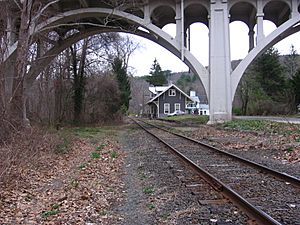Cornwall Bridge facts for kids
Quick facts for kids Cornwall Bridge |
|
|---|---|

View of the Cornwall Bridge Railroad Station through an arched span of the Bridge, March 24, 2012
|
|
| Coordinates | 41°49′10″N 73°22′22″W / 41.81944°N 73.37278°W |
|
Bridge No. 560
|
|
| Area | less than one acre |
| Architect | Connecticut Highway Department; Blakeslee, C.W. & Sons |
| NRHP reference No. | 04001090 |
| Added to NRHP | September 29, 2004 |
| Carries | 2 lanes of |
| Crosses | Housatonic River |
| Locale | Sharon and Cornwall, Connecticut |
| Official name | Bridge No. 560 |
| Maintained by | Connecticut Department of Transportation |
| Characteristics | |
| Design | open spandrel concrete arch |
| Total length | 674 feet (205 m) |
| History | |
| Opened | 1930 |
The Cornwall Bridge is also known as Bridge No. 560. It is a two-lane bridge made of concrete arches. This bridge carries U.S. Route 7 and Connecticut Route 4 over the Housatonic River. It also crosses the Housatonic Railroad in Northwestern Connecticut.
The bridge was built in 1930 by C.W. Blakeslee and Sons. It was made for the Connecticut Highway Department. The bridge has 6 arches with an "open-spandrel" design. This means the arches look open and airy. It stretches for 674 feet (about 205 meters). The Cornwall Bridge is a large example of this type of concrete construction. It was updated and repaired in 1994. In 2004, it was added to the National Register of Historic Places. This means it is recognized as an important historical landmark.
What Makes the Cornwall Bridge Special?
The Cornwall Bridge is located in southwestern Cornwall and southeastern Sharon. It is near a village also called Cornwall Bridge. The bridge runs from east to west. It mainly crosses the Housatonic River, which flows south. It also goes over the tracks of the Housatonic Railroad. These tracks run alongside the river's east bank. Roads named River Road are on each side of the bridge.
The bridge has six main sections with open-spandrel concrete arches. The longest section is 180 feet (about 55 meters) and spans the river. The other five sections are smaller, each 76 feet (about 23 meters) long. Two of these are on the west side of the river, and three are on the east side.
In addition to the arched parts, there are three concrete sections that lead up to the bridge on each side. These are called approach spans. They make the total length of the bridge 859 feet (about 262 meters). The bridge carries two lanes of traffic. It does not have sidewalks for people to walk on.
Why the Open-Spandrel Design?
The "open spandrel" design was chosen for a good reason. It helped to use less concrete. This made the bridge less expensive to build. It also meant the bridge had a smaller "footprint" or base. The Cornwall Bridge is one of only six open-spandrel bridges in Connecticut. It is the largest one of them all. This bridge was part of a state plan to make major roads better and more modern.
A Look Back in Time
The village on the Cornwall side is called Cornwall Bridge. It got its name because a bridge has been in this spot for many years. The current bridge was built in 1930. Before that, there was an older covered bridge here. When the new bridge was built, the old covered bridge was only used by people walking. Sadly, the covered bridge was washed away in a flood in 1936.
After the state built the new bridge, the shops and businesses in the Village of Cornwall Bridge slowly moved. They moved up the hill, away from the river. Now, they are at the main intersection of US Route 7 and Connecticut Route 4. The Cornwall Bridge Railroad Station is still below the new bridge. However, trains have not stopped there since 1972.

